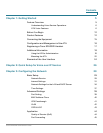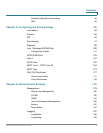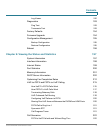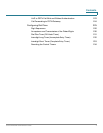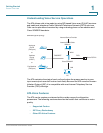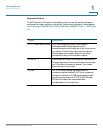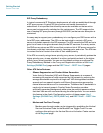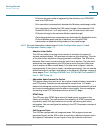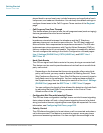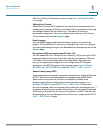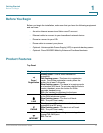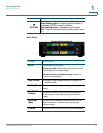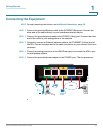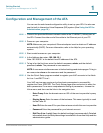
Getting Started
Feature Overview
Cisco SPA232D Administration Guide 9
1
- FAX pass-through mode is triggered by the detection of a CED/CNG
tone or an NSE event.
- Echo canceller is automatically disabled for Modem passthrough mode.
- Echo canceller is disabled for FAX pass-through if the parameter FAX
Disable ECAN (Line 1 or 2 tab) is set to “yes” for that line (in that case
FAX pass-through is the same as Modem pass-through)
- Call waiting and silence suppression are automatically disabled for both
FAX and Modem pass-through. In addition, out-of-band DTMF
transmission is disabled during modem or fax passthrough.
NOTE For more information, please refer to Audio Configuration, page 113 and
Configuration Tables, page117.
• Adaptive Jitter Buffer
The ATA can buffer incoming voice packets to minimize the impact of
variable network delays. This process is known as jitter buffering. The size
of the jitter buffer adjusts to changing network conditions. The ATA has a
Network Jitter Level control setting for each line of service. The jitter level
determines how aggressively the ATA tries to shrink the jitter buffer over
time to achieve a lower overall delay. If the jitter level is higher, it shrinks
more gradually. If jitter level is lower, it shrinks more quickly. You can use the
default settings or configure this feature in the Network Settings section of
these pages: Line 1 Settings (PHONE Port), PSTN (LINE Port), and DECT
Line 1 - DECT Line 10.
• Adjustable Audio Frames Per Packet
This feature allows the user to set the number of audio frames contained in
one RTP packet. Packets can be adjusted to contain from 1–10 audio
frames. Increasing the number of packets decreases the bandwidth utilized,
but it also increases delay and may affect voice quality. You can configure
this setting in the RTP Parameters section of the SIP page.
• DTMF Relay
The ATA may relay DTMF digits as out-of-band events to preserve the
fidelity of the digits. This can enhance the reliability of DTMF transmission
required by many IVR applications such as dial-up banking and airline
information. You can configure this setting in the RTP Parameters section of
the SIP page.
• Call Progress Tones
The ATA has configurable call progress tones. Call progress tones are
generated locally on the ATA so that an end user is advised of status (such
as ringback) Parameters for each type of tone (for instance a dial tone



